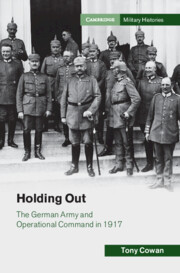Book contents
- Holding Out
- Cambridge Military Histories
- Holding Out
- Copyright page
- Dedication
- Contents
- Figures
- Maps
- Tables
- Acknowledgements
- Comparative Ranks
- Chronology
- Abbreviations
- General key to maps
- Introduction
- 1 Context
- 2 Principles
- 3 Organisation
- 4 Personality
- 5 Intelligence
- 6 Communication
- 7 Learning
- 8 Performance
- Conclusion
- Bibliography
- Index
- Holding Out
- Cambridge Military Histories
- Holding Out
- Copyright page
- Dedication
- Contents
- Figures
- Maps
- Tables
- Acknowledgements
- Comparative Ranks
- Chronology
- Abbreviations
- General key to maps
- Introduction
- 1 Context
- 2 Principles
- 3 Organisation
- 4 Personality
- 5 Intelligence
- 6 Communication
- 7 Learning
- 8 Performance
- Conclusion
- Bibliography
- Index
Summary
Explains the damage done to the German army in 1916 and its poor state at the end of the year. Then describes German remedial action before the major Entente offensive expected in spring 1917: introducing new tactics and improved training; Hindenburg Line withdrawal; increasing the number of divisions on the Western Front; new equipment and organisational structures.
Entente plans to exploit the precarious German situation by simultaneous offensives on the Western Front, Eastern Front and in Italy. After describing the Anglo-French part of this plan, the chapter outlines German foreknowledge of and countermeasures against the offensive. Gives a detailed account of the western battles – Arras including Vimy Ridge and Bullecourt; Nivelle offensive including Aisne, Chemin des Dames, Champagne and Oise; Messines. Links grand strategic, strategic, operational and tactical developments. Outlines events in Russia (Kerensky offensive) and Italy (Isonzo and Asiago), and summarises the overall results of the offensive.
Keywords
- Type
- Chapter
- Information
- Holding OutThe German Army and Operational Command in 1917, pp. 34 - 59Publisher: Cambridge University PressPrint publication year: 2023



